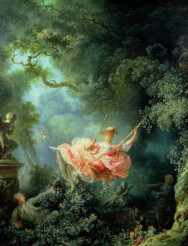
A stunning portrait of myself as Sidonia von Bork by the doyen of femdom art Sardax. A homage to the original Burne-Jones painting (see below). He also uses the arachnid theme and tangled gown pattern to symbolise a woman who can ensnare men in her web; and like the black widow may discard them when she has finished with them.
Sidonia The Sorceress: What’s in a Name?
What’s in a Name? When I first put up a prodom website, years before The English Mansion, anonymity was essential and I decided I would use a pseudonym. It was never a name I was intending to use for myself but I wanted something memorable and unique for search engines. I chose the name of Sidonia von Bork (or Borcke) who was one of the first femme fatales of English literature and of whose portrait I had seen in the Tate Gallery. Sidonia was a historical figure (1548–1620), a Pomeranian noblewoman (an area on the Baltic sea coast, today part Germany, part Poland) who was tried and executed for witchcraft.
She soon, however, became the stuff of legends and in the 19th century was featured in many works of fiction most famously Wilhelm Meinhold’s gothic romance Sidonia the Sorceress translated into English by Oscar Wilde’s mother Lady Wilde (1849). (The book undoubtably influenced one of her son’s sublime children’s stories The Birthday of the Infanta.)

Sidonia von Bork by Burne-Jones.
The novel is set in 16th century Pomerania and chronicles the life and crimes of the evil but captivatingly beautiful Sidonia, who loves cruelty and spends her days tormenting men. She becomes an all-powerful ‘medusa’ figure who gains her power from making the men she seduces sterile – until her eventual downfall. The book was hugely popular in the UK and must be recognised as one of the first explorations of a wicked sexually forceful woman. It was highly regarded by the Pre-Raphaelite Brotherhood and she became the subject of many paintings most famously Sidonia von Bork, 1860 by Sir Edward Coley Burne-Jones.
In the painting we see her in profile lost in her thoughts scheming her heinous plans. In the background stands the Duchess of Wolgast who will become one of her victims. The pattern of her gown is an intricate tangled web and there is a spider at the bottom of the painting both symbolising her power to entrance and ensnare those around her. (The gown’s design is derived from a portrait of Isabella d’Este by Giulio Romano at Hampton Court.)
So I hope I have done her memory justice and that she has been brought back to life to once more wreak her wicked magic and ensnare men in her web.
Visit Sardax’s excellent Blog Here
Also highly recommended the Sardax Venus in Furs hardback & e-book out now!


































































































Fascinating, Mistress Sidonia, and now I have another subject for browsing and further reading. I often wondered from where you got your name, but for some reason imagined that you’d invented it from whole cloth for its evocative sound. As an erotic writer I have done that many times myself. And now Sidonia turns out to have been a real practicing femme fatale of great and fearsome reputation.
I found this statement on the Wikipedia page particularly interesting:
“The English translations achieved a popularity in Great Britain that was unmatched by any other German book in British literary history.” Any other German book? That’s a lot of books to surpass, but I guess the tale of Sidonia the Sorceress really has “legs,” to use the showbiz jargon!
‘Sidonia the Sorceress’ was hugely popular as was ‘She’ by Henry Rider Haggard (1887). Which was considered a classic selling over 83 million copies worldwide and was once one of the best-selling books of all time! Strange two books with a femdom theme being the most popular during the 19th century 🙂
You got me thinking about other enticing femdom literature, Mistress Sidonia, and so I did a post about it on my blog today:
https://irvoneil.wordpress.com/2015/07/26/femdom-thrills-over-the-last-200-years/ I hope you don’t mind my posting the link here, and that you find it interesting!
Great read & loved the images 🙂
Glad you enjoyed it, Mistress Sidonia! Thanks for reading. 🙂